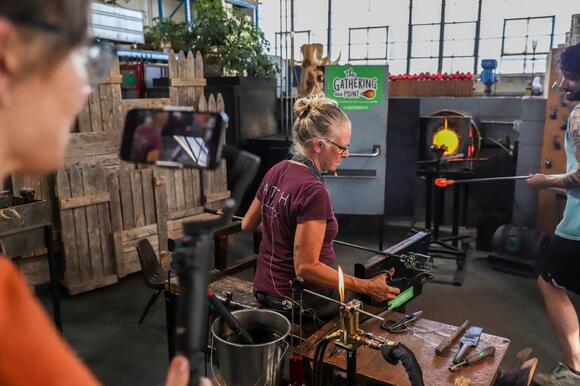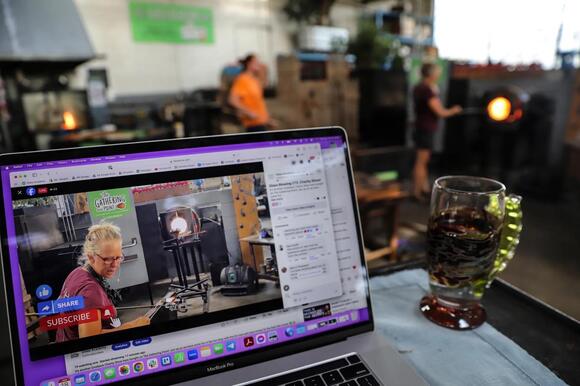Life as a professional glassblower isn't an easy one.
You have to like heat, because a typical nine-to-five is spent on your feet in a hot shop, walking back and forth between blazing ovens either just as hot or hotter than boiling lava. You have to have some physical ability, like good hand-eye coordination to keep a blowpipe spinning and stable hands to create precise details with a giant pair of tweezers. You have to be patient, sometimes spending hours on just one piece, followed by more hours letting it cool. You have to have a passion for the craft, to put up with all of its pains for something that could shatter with one wrong movement or a sharp change in temperature.
But most of all, you have to have perseverance and creativity to keep glassblowing alive in a world where the need for hand-blown glass goods only shrinks.
"We don't buy handmade glass for our homes anymore, there's not enough demand for it, so the only people who are doing this are artists," said Michelle Plucinsky, co-founder of the Glass Academy in Dearborn.

Ever since mass-produced glass rose to popularity, there has been little to no need for hand-blown glass, shifting most hand-blown items from typical household dishware to expensive artworks and collectibles. To immortalize the trade, glassblowers are finding ways to create new meaning for their art and drive interest in their diminishing craft.
"For us, it was how can we create a product that pushes our skill level, but still allows us to sell the (product)?" said Plucinsky. "We have to create, market and sell works that the public can buy and create that desire. Why do they want it? We have to teach them now."
The basics of glassblowing
Glassblowing has existed for at least 2,000 years, reported by some to have been discovered by the Phoenicians when sand combined with soda from their cooking wares and heat left behind shards of glass.
Regardless of who discovered it and when, many of the same principles in glassmaking that existed thousands of years ago persist now: using sand (silica), soda ash, limestone and a ridiculous amount of heat, glassblowers can manipulate the forces of nature to create something functional and beautiful.
Nowadays, glass is usually sent to glassblowers in chips, ready to be thrown into a 2,100-degree furnace that operates 24 hours a day, seven days a week. After about 12 hours in a furnace, the glass melts into a thick goop that can be scooped up on the end of a blowpipe and slowly, carefully worked into a masterpiece.
Artists blow through the pipe to expand the molten glass, then use various other tools and techniques to shape it: rolling it on a steel table called a "marver," using large steel tweezers called "jacks" to pinch and remove glass, tipping the blowpipe upside down and gently swinging it back and forth to let gravity lengthen it, and more. Color is added by rolling the molten mass in fragments of colored glass, whose pigments are added by combining glass with different metals, like cobalt to make blue and manganese to make purple.

As they work, the project has to be routinely reheated in an even hotter furnace called a "glory hole" to quickly warm up works-in-progress and keep them malleable.
"Like porridge, it can't be too hot, too cold; it has to be just right," said Plucinsky.
Through it all, it also has to remain in constant motion, being rotated at the end of the blowpipe like you'd rotate a spit over a fire, to prevent gravity from pulling one side down more than another.
"I would liken it to being like a surgeon. You first have the have the mental understanding of what you're doing, but just knowing doesn't help you if your hands can't keep up with your brain. You have to have the dexterity that goes with it and always be working it," said Oliver Schihl, a glassblowing assistant at the Glass Academy. "You have to work quickly with the glass too. Sometimes when we're doing more intricate pieces, 10 seconds makes all the difference between success and failure."
When the piece is done, glassblowers drip water where the blowpipe connects to the work to rapidly cool it, then with the smallest tap to the blowpipe, the piece breaks from the tip of the pipe. It's then moved to an annealing oven to cool gradually over several hours to prevent the piece from cracking or shattering.
"This is the hardest thing I ever sought out to do. I used to be an engineer before this, and this is hands-down, easily harder," said Schihl. "It's 10 times harder, but it's 10 times more fun."
Remarkable recyclability
It's important to note that glass is the only material that is 100% recyclable and can be recycled over and over again without losing any of its quality, just by throwing it back in a furnace, letting it melt down and reshaping it into something else.
When colored glass is melted down, all pigments melt out except for the cobalt blue, leaving behind glass with a watery blue hue. At the Glass Academy, this blue glass is used to create a special line of products out of scraps, titled "Recycled: 2nd Design Glassware."
"There's no reason why you can't use it again ... or if you might have a little leftover. It's nothing wrong with it, it's just leftover. So, we scoop that up, we throw it in a furnace and everything (comes out) light blue," said Plucinsky.
While the blue glass is the base of Recycled: 2nd Design items as well as other products, Plucinsky also has her trainees practice glassblowing with recycled glass to avoid wasting expensive colors. Recycling glass also helps to save money, since reusing the scraps and broken pieces can help their product stretch longer instead of buying more "new" glass.
Glassblowing meets modern technology
At the Glass Academy, Plucinsky has found numerous ways to keep glassblowing relevant. After all, glassblowing is central to her life.
Plucinsky was always an artist, but it wasn't until she got a job at the Henry Ford Museum's glass shop that she realized how much she truly excelled at the craft.
She later attended the College of Creative Studies in Detroit, where she met another glassblower, who was soon-to-be her husband. They opened the Glass Academy in southwest Detroit after getting married, and although the location has changed, it's remained a family-owned business since; now, 36 years after Plucinsky first picked up a blowpipe.
Over time, the Glass Academy expanded their sales to classes to let the average person come in, try their hand at glassblowing and walk away with something they made and a memory. But during the pandemic, the Glass Academy had to shut the doors to their 14,000-square-foot facility, where rows of hand-made glass trinkets sit for sale adjacent to the hot shop.
Worried about the loss of sales, Plucinsky had the idea to start livestreaming the Glass Academy team making their creations as another way to display their recent products, but she quickly found that the audience enjoyed tuning in to learn something new and see exactly how their latest treasure was made.

"(I thought) 'How can we create a culture or a following?'" said Plucinsky. "I think it's really important to get people involved in the arts, because whether it's ceramics, or textiles, or leather, once you understand (it), you understand why each product costs what it does − and this is an easy, showy one to do."
Plucinsky and her crew still do their weekly livestreams, now known as "The Gathering Point," every Tuesday at 6 p.m., now with a variety of interactive features to engage viewers more than ever before.
Breath of Michigan
In 2022, Plucinsky wanted to take a shot at something new: a Guinness world record attempt. But she didn't want to do it alone, or even with her team; she wanted to do something special that would involve the community.
The Glass Academy began a new class, called "Breath of Michigan," that would allow the public to come in and learn how to blow two spheres − one to keep and one to join the world record attempt − using their recycled glass, creating bubbles as blue as the Great Lakes.
On July 31, 2022, after just six weeks of Breath of Michigan classes, the project had accumulated 1,053 bubbles , successfully winning "Largest Display of Glass Items."
"Breath of Michigan was a way to pull together the community...And then when (it's all put together), it's a breath of everyone," said Plucinsky.
The Glass Academy has continued their Breath of Michigan classes , stacking up more and more blue baubles to be incorporated into a sculpture and other decor.
Marketing memories
Full of fresh ideas, Plucinsky's newest business venture bravely steps into foreign different terrain: adding a bar to the Glass Academy.
Plucinsky has been working on acquiring a liquor license and converting the facility's extra space into a bar area, complete with the Breath of Michigan sculpture and extra bubbles decorating a glowing trough in the floor. Customers will be able to come to the bar and enjoy a cocktail in one of the glasses made just a wall away in the hot shop.

Looking at her own son, she says a bar stocked with hand-blown glass pieces is a way to get younger generations to appreciate glassblowing and consider purchasing a piece for themselves. The nature of hand-blown glass' collectability is changing; while older generations collected fine glass dishware and trinkets to display, younger generations are more likely to spend a little more money on an object when there's a memory attached to it.
"I don't think that (younger) generations will collect like my generation and older might, but they'll have a cocktail at the bar and buy that one glass," said Plucinsky. "(Or they'll) come to a class to experience it, try it...They might buy something now that they understand the process."
This article originally appeared on Detroit Free Press: Glassblowers find new ways to drive interest in diminishing craft at Dearborn academy
 Most Popular
Most Popular




Comments / 0